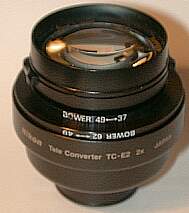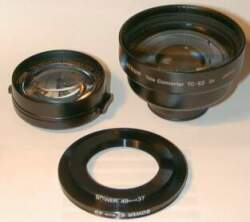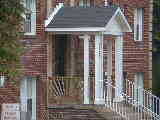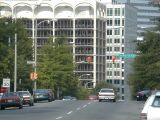The 300mm "Double-Teleconverter"
 visitors since June 19, 1999
visitors since June 19, 1999
 visitors since June 19, 1999
visitors since June 19, 1999
Update: July 7, 1999. I noticed today that pictures taken through the double-teleconverter using the camera's smallest aperture (F9.9 on my Nikon 900 at full zoom), are much sharper at the edges. The picture on the right (below) was taken at F9.9 and is noticeably better than the one using a wider aperture. For cameras without an aperture priority mode, this means that pictures taken in bright daylight (when then the camera will choose smaller apertures) are likely to be considerably sharper than those taken in lower light. If you have a camera which allows you to set the aperture, try using the smallest aperture (i.e. largest F-number) possible.
The images produced by the double-teleconverter are pretty good, but not perfect. There is some blurring visible in the corners of the images, although it is suprisingly minor considering the Rube Goldberg nature of the device. The centers of the images are very sharp. If one crops the image slightly, all blurring can be removed.
In fact, starting with a 1600x1200 image produced by a Nikon 950 using this technique, and cropping a 1024x768 image out of the center, produces an image that is the same as one taken with a 12x zoom lens on a 1024x768 camera. Maybe that 14x zoom on the Sony Mavica FD-91 doesn't seem quite so unbelievable after all! Below are some sample images taken with the double-converter. Click on the thumbnails to see the full-sized originals. Send any comments to Max Lyons ([email protected])
 June 19, 1999. One way of creating a reasonable 300mm equivalent lens for for the Nikon 900/950 digital camera is to use two teleconverters simultaneously. I use a Nikon 2.0x (Model TC E2) and a Tiffen 1.5x teleconverter. The Nikon teleconverter has a 62mm threaded end onto which one can attach a step-down ring and the 37mm-threaded Tiffen teleconverter. I use two step-down rings (62mm-49mm and 49mm-37mm), available from B&H; Photo for about $6-7 each to accomplish this. I suppose one could use any combination of teleconverters to do this, but the teleconverter that attaches to the camera must have a threaded end. Additionally, since two teleconverters double the opportunity to introduce distortions and image problems, it is important to use high quality teleconverters. Having tried several, I've concluded that the Nikon 2.0x and Tiffen 1.5x are two of the best.
June 19, 1999. One way of creating a reasonable 300mm equivalent lens for for the Nikon 900/950 digital camera is to use two teleconverters simultaneously. I use a Nikon 2.0x (Model TC E2) and a Tiffen 1.5x teleconverter. The Nikon teleconverter has a 62mm threaded end onto which one can attach a step-down ring and the 37mm-threaded Tiffen teleconverter. I use two step-down rings (62mm-49mm and 49mm-37mm), available from B&H; Photo for about $6-7 each to accomplish this. I suppose one could use any combination of teleconverters to do this, but the teleconverter that attaches to the camera must have a threaded end. Additionally, since two teleconverters double the opportunity to introduce distortions and image problems, it is important to use high quality teleconverters. Having tried several, I've concluded that the Nikon 2.0x and Tiffen 1.5x are two of the best.
 Because the Tiffen lens is relatively small and light, the "double-teleconverter" does not weigh much more than the Nikon teleconverter alone. Once assembled, the double-teleconverter feels pretty solid and is quite easy to use with the camera. I use one hand to support it, although this is probably not a necessity. Because the Tiffen 1.5x does not quite live up to its billing (it is more like a 1.25x or 1.3x teleconverter), the double teleconverter gives about a 2.6x boost. This increases the Nikon's 115mm lens to about 300mm.
Because the Tiffen lens is relatively small and light, the "double-teleconverter" does not weigh much more than the Nikon teleconverter alone. Once assembled, the double-teleconverter feels pretty solid and is quite easy to use with the camera. I use one hand to support it, although this is probably not a necessity. Because the Tiffen 1.5x does not quite live up to its billing (it is more like a 1.25x or 1.3x teleconverter), the double teleconverter gives about a 2.6x boost. This increases the Nikon's 115mm lens to about 300mm.
 Aperture: F3.6 Exposure EV: 9.5 |
 Aperture: F9.9 Exposure EV: 13.2 |